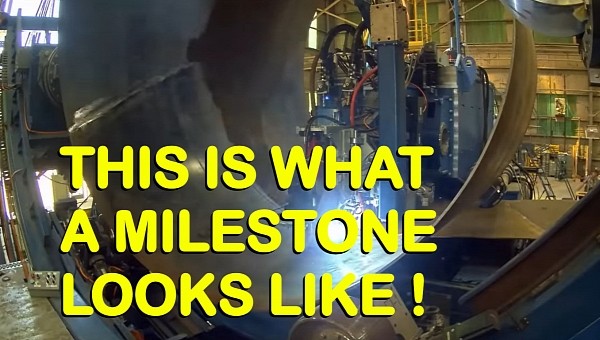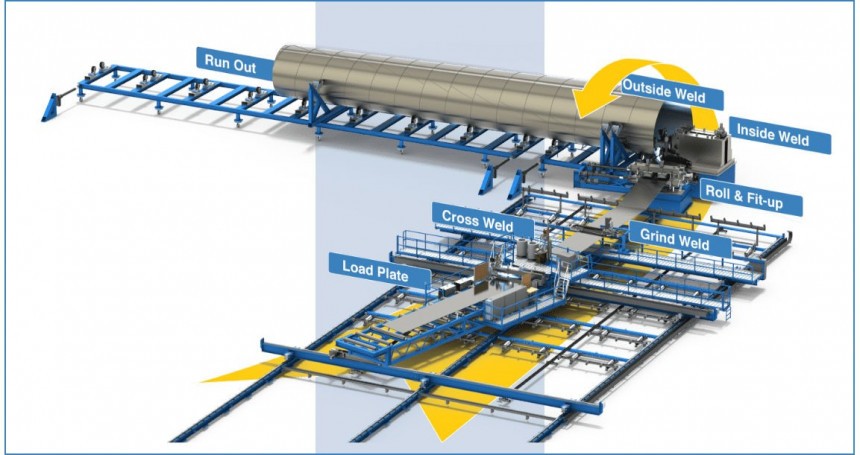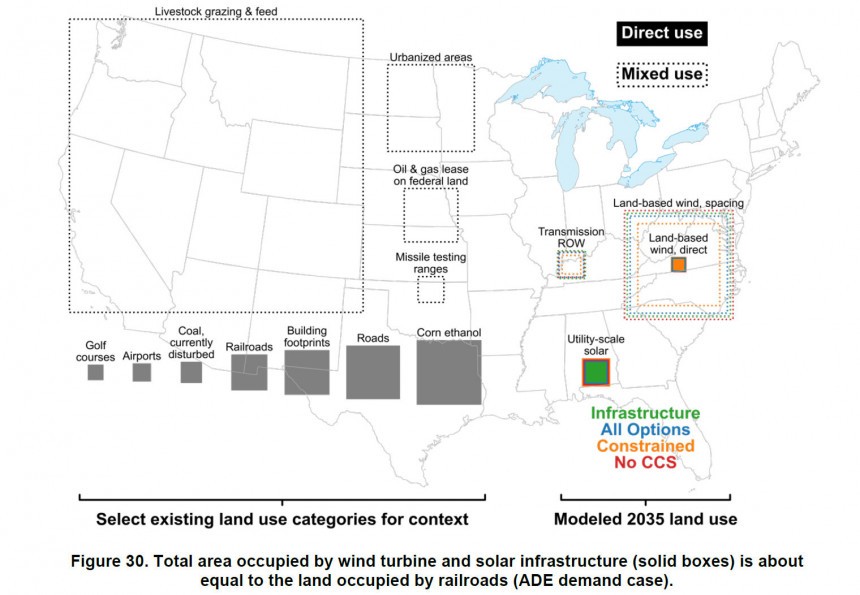Building towers for wind turbines 10 times faster and up to twice as tall as today’s conventional technology is something for prime-time news. The new technology can help speed up the deployment of new wind farm projects, on- and offshore. This means “electrify everything” could be much closer than many expect.
Make no mistake, except for the ‘Keystone’ name, there’s no link between the Keystone XL Pipeline project in the oil industry and the Keystone Tower Systems company in the wind industry. Their history is very different.
In 2015, the oil pipe project was put on hold by Obama when it attracted opposition from environmentalists. The same year, Keystone Tower Systems installed the world’s first tapered spiral welded tower as a pilot project in Middleton, Massachusetts.
In 2017, Trump revived the oil project, while the non-oil company received full certification from DNV for its groundbreaking technology. In 2021, Biden suspended the permit for Keystone XL Pipeline, while Keystone Tower Systems commissioned its first full-scale plant for onshore tower manufacturing.
In 2023, the oil industry’s project is dead, while the Denver-based company partnered with GE Renewable Energy to announce the operation of the first commercial spiral-welded wind tower. It’s a milestone for the wind industry, but first, let’s see what’s this ‘spiral welding’ all about.
Basically, coils of steel are fed to the machinery, where they are unwound and flattened. The long strip is going through a forming process by angled rollers and is turned into a cylinder. When the coil is finished, a new coil is welded to the edge, and the process continues.
Spiral-welded pipes are used mostly for water distribution and oil. Now, isn’t it just funny that a technique used for the now-defunct Keystone oil pipeline accelerates the construction of zero-emissions wind turbine towers? Sometimes, life just laughs in your face. Well, not your face, but Big Oil.
But wait, there’s more to it! Keystone’s factory in Pampa, Texas, was built at a facility that used to make drilling equipment for the oil and gas industry. Facepalm, Big Oil, because the new factory brings back nearly 200 jobs to the region. But why is this a big thing?
Simple math shows us that this factory can produce one such welded tower per day. This is 10 times faster than current manufacturing for conventional towers. The new spiral-welded tower was certified by TÜV NORD for a 40-year lifetime, and it’s designed to be interchangeable with GE’s conventional 89m tall tower.
The next step will be manufacturing a spiral-welded tower to replace the highest 492-feet-tall (150-meter-tall) GE wind turbine with the largest 433-feet (132-meter) rotor diameter. And then the two companies will work on a new spiral-welding machine for the 3 MW platform GE turbines.
But the key aspect of this spiral welding technique is the smaller footprint and modular design of the machinery. This means the tower production can be brought to the project site, thus eliminating transport constraints and huge logistics issues.
This is also in handy for offshore wind, which is rapidly expanding. For instance, the U.S. offshore wind power is projected to grow to 30 GW by 2030. Using port-side production facilities and scaling up spiral welding will allow U.S. manufacturing to leapfrog the industry.
It also enables towers to be scaled to any size. A taller tower means the rotor reaches stronger winds, so it’s much more efficient over its entire lifespan. As the industry races towards larger rotors, so is the need for bigger and better towers.
Many think this revolution is impossible, but the National Renewable Energy Laboratory suggests it is within reach. According to its study, to achieve zero-carbon electricity by 2035, the wind and solar power in the electricity mix must increase from 14% in 2022 to 75% in 2035.
That’s more than a five-fold increase in capacity in 12 years span. But there’s more to it. The growing demand for electricity means that the combined solar and wind capacity needs to surpass 2,000 GW. The growth rate for solar is projected in the range of 43 to 90 GW/year, while for wind it is 70 to 145 GW/year.
Simply put, by 2035 the U.S. will need roughly 250,000 wind turbines. “Whoa, that’s a lot!” will probably be the first thing that comes to mind of renewables detractors. Yes, it is. And this is why technologies like spiral-welding towers for wind turbines are of great importance.
In short, it would take less than one percent of the U.S. land, not including Alaska and Hawaii. That’s about 20,000 square miles (51,800 square km). To put things in perspective, let’s see some comparisons:
NREL didn’t count the amount of land needed for transporting and storing fossil fuels, nor for disposing of the waste, like the coal ash. Compared to fossil fuels, land use for solar and wind is unsurprisingly a zillion times more environmentally friendly.
Imagine that only two percent of the total land area within a wind farm is actually filled by wind turbines. Most of the land can be used primarily for agriculture. Unless wind turbines detractors will find ‘evidence’ that rotors are affecting crops or cattle herds.
Solar panels are becoming a viable option for agricultural areas, as the ‘agrivoltaic’ trend is becoming more popular. Also, utility-scale solar projects can be placed on disturbed or contaminated land that can be reused, while rooftop solar simply doesn’t need any land.
We cannot omit that the grid infrastructure needs serious upgrading. By 2035, it is projected to increase three times over current levels, with 10,000 miles (16,000 km) of new high-capacity lines per year. This is a huge investment, indeed, and it adds to the billions needed for wind and solar projects.
Then there are estimated around $400 billion (€376 billion) in savings in avoided mortality costs. NREL suggests that up to 130,000 premature deaths will be avoided by 2035. The avoided cost of natural disasters due to climate change is estimated at $1.2 trillion (€1.13 billion).
So, in the end, the overall benefit to society will range from $920 billion to $1,200 billion (€865 to €1,130 billion) in 2035. It turns out that the big costs of ditching fossil fuels in favor of renewables are translating to huge savings. At least, this is what the NREL study concludes.
Now you can understand why the first commercial spiral-welded wind turbine tower is another milestone for renewables. It’s another solid proof that the business-as-usual fossil fuel-based energy sector can be decarbonized at a fast pace.
In 2015, the oil pipe project was put on hold by Obama when it attracted opposition from environmentalists. The same year, Keystone Tower Systems installed the world’s first tapered spiral welded tower as a pilot project in Middleton, Massachusetts.
In 2017, Trump revived the oil project, while the non-oil company received full certification from DNV for its groundbreaking technology. In 2021, Biden suspended the permit for Keystone XL Pipeline, while Keystone Tower Systems commissioned its first full-scale plant for onshore tower manufacturing.
In 2023, the oil industry’s project is dead, while the Denver-based company partnered with GE Renewable Energy to announce the operation of the first commercial spiral-welded wind tower. It’s a milestone for the wind industry, but first, let’s see what’s this ‘spiral welding’ all about.
A technique borrowed from the steel-pipeline industry
Spiral welding is a technique used for manufacturing long metal pipelines. The steel used to make the tower is curled into a cylinder. The principle is very simple and much more efficient than longitudinal welded pipes.Basically, coils of steel are fed to the machinery, where they are unwound and flattened. The long strip is going through a forming process by angled rollers and is turned into a cylinder. When the coil is finished, a new coil is welded to the edge, and the process continues.
Spiral-welded pipes are used mostly for water distribution and oil. Now, isn’t it just funny that a technique used for the now-defunct Keystone oil pipeline accelerates the construction of zero-emissions wind turbine towers? Sometimes, life just laughs in your face. Well, not your face, but Big Oil.
But wait, there’s more to it! Keystone’s factory in Pampa, Texas, was built at a facility that used to make drilling equipment for the oil and gas industry. Facepalm, Big Oil, because the new factory brings back nearly 200 jobs to the region. But why is this a big thing?
The secret sauce: mobile factories
The Keystone’s factory will be capable of producing approximately 1GW of towers per year when at full capacity. The first product is a 292-feet-tall (89-meter-tall) spiral welded tower for the GE 2.8-127 turbine, with a rated power of 2,800 kW.Simple math shows us that this factory can produce one such welded tower per day. This is 10 times faster than current manufacturing for conventional towers. The new spiral-welded tower was certified by TÜV NORD for a 40-year lifetime, and it’s designed to be interchangeable with GE’s conventional 89m tall tower.
The next step will be manufacturing a spiral-welded tower to replace the highest 492-feet-tall (150-meter-tall) GE wind turbine with the largest 433-feet (132-meter) rotor diameter. And then the two companies will work on a new spiral-welding machine for the 3 MW platform GE turbines.
But the key aspect of this spiral welding technique is the smaller footprint and modular design of the machinery. This means the tower production can be brought to the project site, thus eliminating transport constraints and huge logistics issues.
It also enables towers to be scaled to any size. A taller tower means the rotor reaches stronger winds, so it’s much more efficient over its entire lifespan. As the industry races towards larger rotors, so is the need for bigger and better towers.
How many wind turbines are needed in the U.S.?
For the U.S. to achieve net-zero emissions by 2050, first it must cut in half the heat-trapping emissions by 2030. To do that, the energy sector will require an unprecedented increase in wind and solar, while zero-carbon electricity will replace fossil fuel in the building, industrial and transportation sectors.Many think this revolution is impossible, but the National Renewable Energy Laboratory suggests it is within reach. According to its study, to achieve zero-carbon electricity by 2035, the wind and solar power in the electricity mix must increase from 14% in 2022 to 75% in 2035.
That’s more than a five-fold increase in capacity in 12 years span. But there’s more to it. The growing demand for electricity means that the combined solar and wind capacity needs to surpass 2,000 GW. The growth rate for solar is projected in the range of 43 to 90 GW/year, while for wind it is 70 to 145 GW/year.
Simply put, by 2035 the U.S. will need roughly 250,000 wind turbines. “Whoa, that’s a lot!” will probably be the first thing that comes to mind of renewables detractors. Yes, it is. And this is why technologies like spiral-welding towers for wind turbines are of great importance.
How much land is needed for solar and wind?
This is a legit question and NREL has the answer. The agency calculated how much space is needed for all the solar and wind farms, along with all the transmission lines for electricity in the 2035 zero-emissions electricity scenario.- it is 30% more than the 13,100 sq. mi. (34,800 sq. km) disturbed land for coal mining;
- it is slightly more than the 18,500 sq. mi. (47,900 sq. km) occupied by the entire railroad network;
- it is less than half of the 40,500 sq. mi. (105,000 sq. km) for the 1.5 million oil and gas active wells;
- it is 30% less than the almost 60,000 sq. mi. (155,000 sq. km) currently needed for ethanol production.
NREL didn’t count the amount of land needed for transporting and storing fossil fuels, nor for disposing of the waste, like the coal ash. Compared to fossil fuels, land use for solar and wind is unsurprisingly a zillion times more environmentally friendly.
Imagine that only two percent of the total land area within a wind farm is actually filled by wind turbines. Most of the land can be used primarily for agriculture. Unless wind turbines detractors will find ‘evidence’ that rotors are affecting crops or cattle herds.
Solar panels are becoming a viable option for agricultural areas, as the ‘agrivoltaic’ trend is becoming more popular. Also, utility-scale solar projects can be placed on disturbed or contaminated land that can be reused, while rooftop solar simply doesn’t need any land.
We cannot omit that the grid infrastructure needs serious upgrading. By 2035, it is projected to increase three times over current levels, with 10,000 miles (16,000 km) of new high-capacity lines per year. This is a huge investment, indeed, and it adds to the billions needed for wind and solar projects.
There is a cost. And a benefit
The climate and health benefits of decarbonization offset the costs, according to the NREL study. Additional power systems costs will amount to $740 billion (€696 billion). In the meantime, the substantial reduction in petroleum, coal, and natural gas will offset a part of these costs.Then there are estimated around $400 billion (€376 billion) in savings in avoided mortality costs. NREL suggests that up to 130,000 premature deaths will be avoided by 2035. The avoided cost of natural disasters due to climate change is estimated at $1.2 trillion (€1.13 billion).
So, in the end, the overall benefit to society will range from $920 billion to $1,200 billion (€865 to €1,130 billion) in 2035. It turns out that the big costs of ditching fossil fuels in favor of renewables are translating to huge savings. At least, this is what the NREL study concludes.
Now you can understand why the first commercial spiral-welded wind turbine tower is another milestone for renewables. It’s another solid proof that the business-as-usual fossil fuel-based energy sector can be decarbonized at a fast pace.









